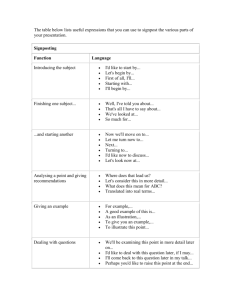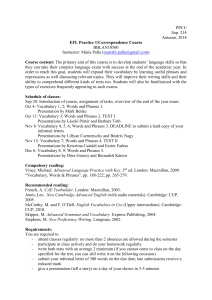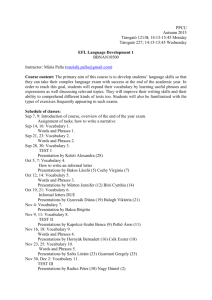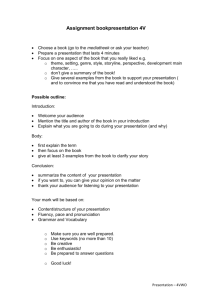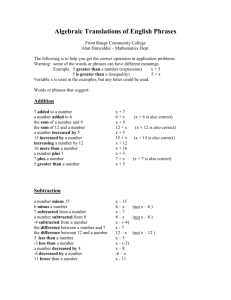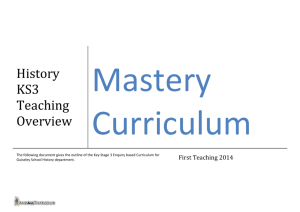File
advertisement
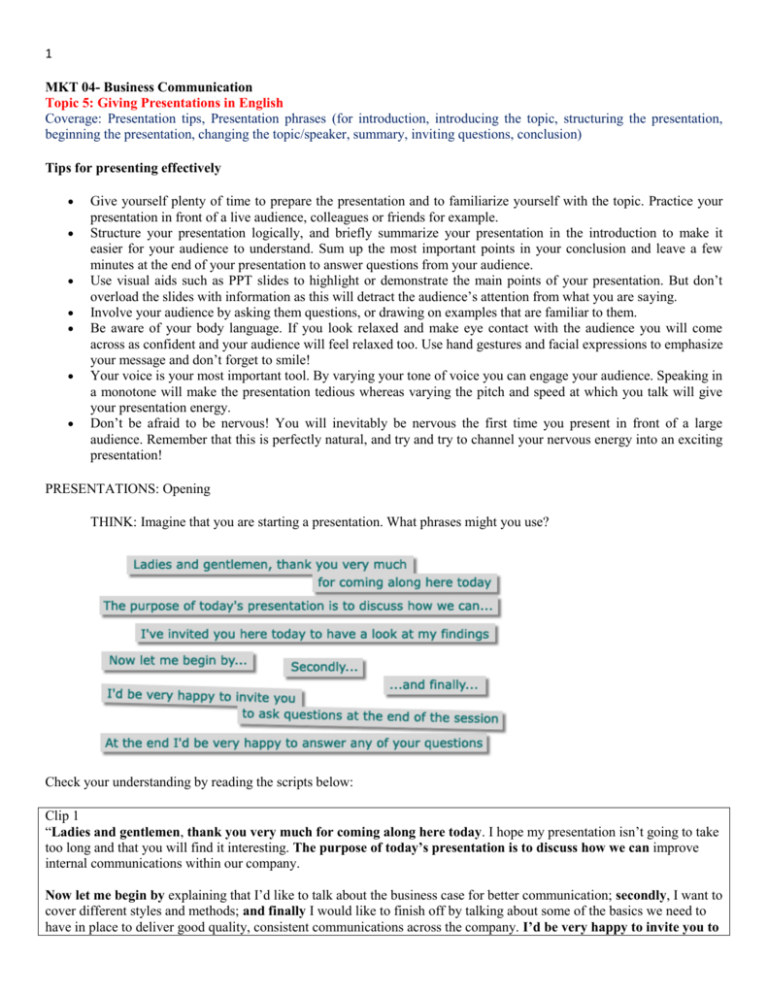
1 MKT 04- Business Communication Topic 5: Giving Presentations in English Coverage: Presentation tips, Presentation phrases (for introduction, introducing the topic, structuring the presentation, beginning the presentation, changing the topic/speaker, summary, inviting questions, conclusion) Tips for presenting effectively Give yourself plenty of time to prepare the presentation and to familiarize yourself with the topic. Practice your presentation in front of a live audience, colleagues or friends for example. Structure your presentation logically, and briefly summarize your presentation in the introduction to make it easier for your audience to understand. Sum up the most important points in your conclusion and leave a few minutes at the end of your presentation to answer questions from your audience. Use visual aids such as PPT slides to highlight or demonstrate the main points of your presentation. But don’t overload the slides with information as this will detract the audience’s attention from what you are saying. Involve your audience by asking them questions, or drawing on examples that are familiar to them. Be aware of your body language. If you look relaxed and make eye contact with the audience you will come across as confident and your audience will feel relaxed too. Use hand gestures and facial expressions to emphasize your message and don’t forget to smile! Your voice is your most important tool. By varying your tone of voice you can engage your audience. Speaking in a monotone will make the presentation tedious whereas varying the pitch and speed at which you talk will give your presentation energy. Don’t be afraid to be nervous! You will inevitably be nervous the first time you present in front of a large audience. Remember that this is perfectly natural, and try and try to channel your nervous energy into an exciting presentation! PRESENTATIONS: Opening THINK: Imagine that you are starting a presentation. What phrases might you use? Check your understanding by reading the scripts below: Clip 1 “Ladies and gentlemen, thank you very much for coming along here today. I hope my presentation isn’t going to take too long and that you will find it interesting. The purpose of today’s presentation is to discuss how we can improve internal communications within our company. Now let me begin by explaining that I’d like to talk about the business case for better communication; secondly, I want to cover different styles and methods; and finally I would like to finish off by talking about some of the basics we need to have in place to deliver good quality, consistent communications across the company. I’d be very happy to invite you to 2 ask questions at the end of the session and I’m sure there’ll be plenty of time for us to discuss some of the points that have been raised.” Clip 2 “Good afternoon, ladies and gentlemen. Thank you for finding the time to come and join me for this presentation this afternoon. My name is Tim Mason, I‘m a retail consultant, and many of you will have seen me shadowing you in your jobs and looking through the accounts and so on in the company over the last week. I’ve invited you here today to have a look at my findings. First, I’d like to have a look at the performance of the company, the sales of the company over the last three years; then I’d like to have a look at our market share in the womenswear market and look at our competitors; and thirdly, I’d like to suggest some improvements in our range of womenswear. At the end I’d be happy to answer any of your questions.” PRESENTATIONS: Body Introduction After you have greeted your guests, you will begin to go through the main body of your presentation. It's very useful to have some visual aids - some slides, pictures or graphs that help explain what you are saying. Sometimes they can also help to keep your audience interested in your presentation! THINK: Imagine you are giving a presentation and using some visual aids. What phrases might you use to draw your audience’s attention to these slides? Check your understanding by reading the scripts below: Clip 1 “If you have a look at this first graph, you can see that our sales topped 50 million the year before last. Then last year sales dropped to 40 million, with a slight recovery at the end of the financial year. However, this year sales have continued to drop to an all time low of 30 million. Now let’s look at our market share. As you can see, we have 25% of the market share, 10% down on last year.” Clip 2 “A good example of how important internal communications are is shown by some findings from research that we have recently undertaken. Good communications is a very key factor in staff motivation. If you look at this slide, you will see how important it is to get the basics in place. You need to identify your communication requirement, agree your objectives and success criteria, identify your target audiences, define the content of your message and determine the style of delivery. A good illustration of the communication process is when all those basics fall into place naturally.” 3 PRESENTATIONS: Questions At the end of your presentation, you may wish to open the floor to questions – to ask if anyone has any questions about your presentation. Think: Imagine it is the end of your presentation and you are asking if there are any questions. What phrases might you use or hear? Check your understanding by reading the script below: Tim: Ladies and gentlemen, if you have any questions, I'd be happy to answer them now. Carrie: Yeah, can I just ask, graph number 3, that last one you showed us, can you explain to me where you’re intending to find the extra income to increase the designer range in the maternity wear? Tim: Yes, a very good question. I’ve looked at the office wear range and it’s quite heavy on material, holiday wear tends to be much lighter, much smaller amounts of material involved and I ... Helpful Phrases for a Presentation The following are useful phrases to provide you with the basic structure of a presentation in English. Introduction On behalf of… (name of office/company) I would like to welcome you here today. My name is… and I am the… (your designation/position in the company). Hi, I'm… and I am the …(your position and name of office/company). Good morning/afternoon/evening, ladies and gentlemen. My name is…and I am delighted to be here today to talk to you about… Hi everyone, I'm…(name) from …(office/company) and today I'd like to talk to you about… Introducing the topic 4 Today I am here to talk to you about… As you all know, today I am going to talk to you about… I would like to take this opportunity to talk to you about… I am delighted to be here today to tell you about… Today I would like to outline… Structuring the presentation My talk is divided into x parts. I'll start with / Firstly I will talk about… / I'll begin with… then I will look at … Next… and finally… I will be glad to answer any questions that you may have at the end. Beginning the presentation I'll start with some general information on… I'd just like to give you some background information about… Before I start, does anyone know…? As you are all aware / As you all know… Changing the topic/speaker Right, let's move on to… This leads me to my next point, which is… I'd now like to look at / consider… Now I will pass you over to /hand over to… (say the name of the next speaker, if any). Does anyone have any questions before I move on? Summary To sum up… So to summarize the main points of my talk… Just a quick recap of my main points… Inviting questions Does have anyone have any questions? 5 I will be happy to answer your questions now If you have any questions, please don't hesitate to ask If you have any further questions, I will be happy to talk to you at the end. Conclusion I'd like to conclude by… That brings me to the end of my presentation, thank you for listening / thank you for your attention. Thank you for listening. It was a pleasure being here today. Well that's it from me. Thank you very much. PRESENTATIONS: Language Expert Introduction A good way to make your presentations effective, interesting and easy to follow is to use signpost language. 'Signpost language' is the words and phrases that people use to tell the listener what has just happened, and what is going to happen next. In other words, signpost language guides the listener through the presentation. A good presenter will usually use a lot of signpost language, so it is a good idea to learn a few of the common phrases, even if you spend more time listening to presentations than giving them! Signpost language is usually fairly informal, so it is relatively easy to understand. Signposting Section of presentation Signpost language Introducing the topic The subject/topic of my talk is ... I'm going to talk about ... My topic today is… My talk is concerned with ... Overview (outline of presentation) I’m going to divide this talk into four parts. There are a number of points I'd like to make. Basically/ Briefly, I have three things to say. I'd like to begin/start by ... Let's begin/start by ... First of all, I'll... … and then I’ll go on to … Then/ Next ... Finally/ Lastly ... Finishing a section That's all I have to say about... We've looked at... 6 So much for... Starting a new section Moving on now to … Turning to... Let’s turn now to … The next issue/topic/area I’d like to focus on … I’d like to expand/elaborate on … Now we'll move on to... I'd like now to discuss... Let's look now at... Analyzing a point and giving recommendations Where does that lead us? Let's consider this in more detail... What does this mean for...? Translated into real terms... Why is this important? The significance of this is... Giving examples For example,... A good example of this is... As an illustration,... To give you an example,... To illustrate this point... Summarizing and concluding To sum up ... To summarise... Right, let's sum up, shall we? Let's summarise briefly what we've looked at... If I can just sum up the main points... Finally, let me remind you of some of the issues we've covered... To conclude... In conclusion ... In short ... So, to remind you of what I’ve covered in this talk, … Unfortunately, I seem to have run out of time, so I’ll conclude very briefly by saying that ….. I'd like now to recap... Paraphrasing and clarifying Simply put... In other words....... So what I’m saying is.... To put it more simply.... To put it another way.... Invitation to discuss / ask questions I’m happy to answer any queries/ questions. Does anyone have any questions or comments? Please feel free to ask questions. 7 If you would like me to elaborate on any point, please ask. Would you like to ask any questions? Any questions? Activity/ Output: Imagine that you are making a presentation to a large group of people working in your industry. How do you start your presentation? Be able to use some of the phrases you have learnt in this lesson. Remember to get the level of politeness and friendliness right! References: Sweeney, S. 2010. English For Business Communication. Cambridge University Press. Talking Business. In BBC: Learning English. Retrieved October 31, 2013, from http://www.bbc.co.uk/worldservice/learningenglish/business/talkingbusiness/unit3presentations/2body.shtml
